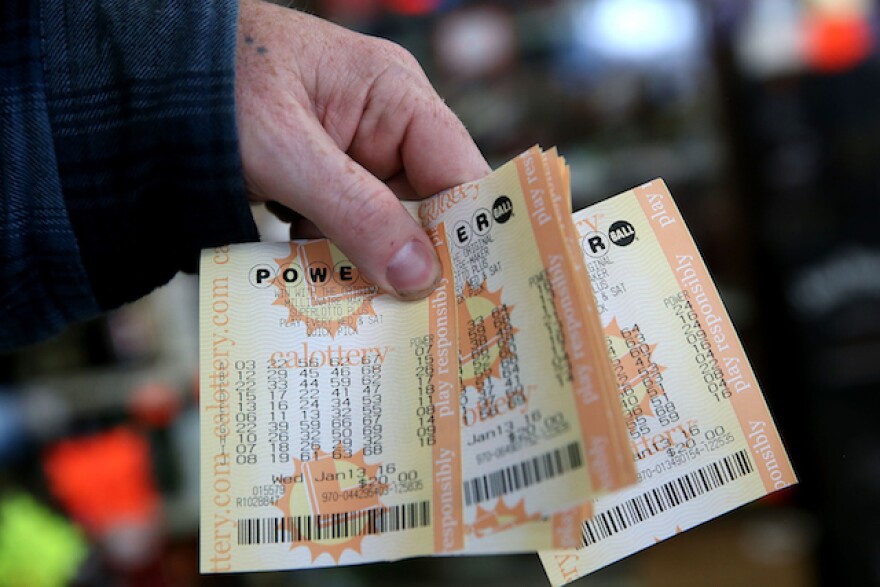With our free press under threat and federal funding for public media gone, your support matters more than ever. Help keep the LAist newsroom strong, become a monthly member or increase your support today.
What Little We Know About That $2B Lottery Winner And Why Money Going To Schools Has An Asterisk

The California winner of the $2.04 billion Powerball jackpot has been named — and some of that money will trickle down to the state's education system.
The California Lottery announced on Twitter that Edwin Castro is the winner of the record-setting jackpot. That ticket was purchased at Joe's Service Center on Woodbury Road in Altadena.
Castro — who declined to appear at the news conference — indicated that he’s taking the lump sum, which comes in at just under $1 billion.
A statement from Castro read by a lottery official Tuesday said he was "shocked and ecstatic" to win. Castro also said that he was educated in California public schools and pleased that state schools would benefit from his winning ticket.
Lottery officials said beyond his name, which is public record in California, and the statement he provided, they'd give out no further details about Castro.
Where does the money go?
According to the California Lottery, the lottery has given California public schools more than $41 billion since 1985, and gave around $2 billion to public schools in the last two years alone — which is roughly 1% of the state’s annual budget for public schools.
The share of the pie breaks down like this:
- K-12: 79.9%
- Community Colleges: 14%
- Cal State University system: 3.7%
- University of California campuses: 2.3%.
More numbers to remember
1, 2, 20, 37, 41, and 23. But those aren't the numbers that won the Powerball.
The California lottery raised about 1% of the state's annual budget for public schools. In the last two years alone, it raised about $2 billion.
Of the money earmarked for education, 80% goes to K-12 schools, and the remaining 20% goes toward higher education, most of it to California Community Colleges, as noted above.
The lottery began in 1985 after the successful passage of Prop 37. According to the California Lottery, the lottery has given California public schools more than $41 billion since 1985.
And the benefit to education is an ongoing point of emphasis:
And if you missed today’s exciting news conference at #CALottery headquarters, check it out here:https://t.co/BgN91o8Uhd
— CA Lottery Press (@calotterypress) February 14, 2023
(2/2)
Funding changes
The breakdown of funds of the last few decades is impressive.
But according to a 2018 LAist investigation, contributions to education by the lottery largely remain unchanged, even as revenues increase by billions of dollars.
That’s because a 2010 law changed the percentage of funding that goes to education, from the 34% set in Prop 37, to, effectively, 23%. The percentage that goes to K-12 schools and higher education has mostly remained the same.
According to the California Lottery, the amount of money available is based on how many tickets they sell that year. But the funding provides flexible options to the schools, and many have used it for computer labs, science programs, and art and music programs.
The lottery says it is not involved in the decision process for determining how a school system spends its money, or where.
At LAist, we believe in journalism without censorship and the right of a free press to speak truth to those in power. Our hard-hitting watchdog reporting on local government, climate, and the ongoing housing and homelessness crisis is trustworthy, independent and freely accessible to everyone thanks to the support of readers like you.
But the game has changed: Congress voted to eliminate funding for public media across the country. Here at LAist that means a loss of $1.7 million in our budget every year. We want to assure you that despite growing threats to free press and free speech, LAist will remain a voice you know and trust. Speaking frankly, the amount of reader support we receive will help determine how strong of a newsroom we are going forward to cover the important news in our community.
We’re asking you to stand up for independent reporting that will not be silenced. With more individuals like you supporting this public service, we can continue to provide essential coverage for Southern Californians that you can’t find anywhere else. Become a monthly member today to help sustain this mission.
Thank you for your generous support and belief in the value of independent news.

-
What do stairs have to do with California’s housing crisis? More than you might think, says this Culver City councilmember.
-
Yes, it's controversial, but let me explain.
-
Doctors say administrator directives allow immigration agents to interfere in medical decisions and compromise medical care.
-
The Palisades Fire erupted on Jan. 7 and went on to kill 12 people and destroy more than 6,800 homes and buildings.
-
People moving to Los Angeles are regularly baffled by the region’s refrigerator-less apartments. They’ll soon be a thing of the past.
-
Experts say students shouldn't readily forgo federal aid. But a California-only program may be a good alternative in some cases.







